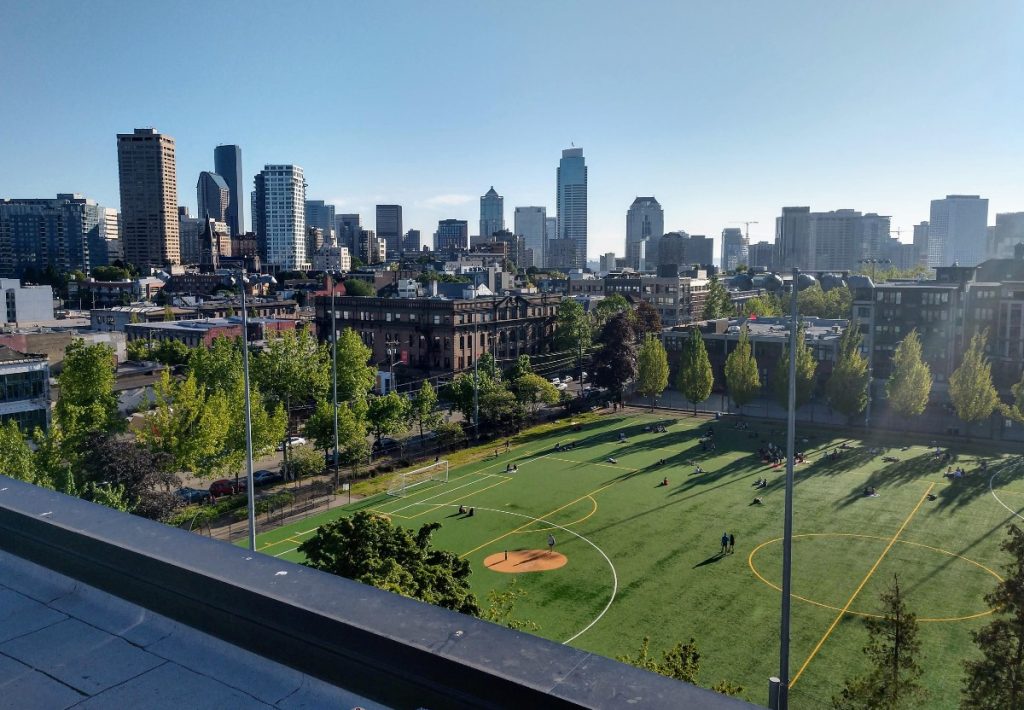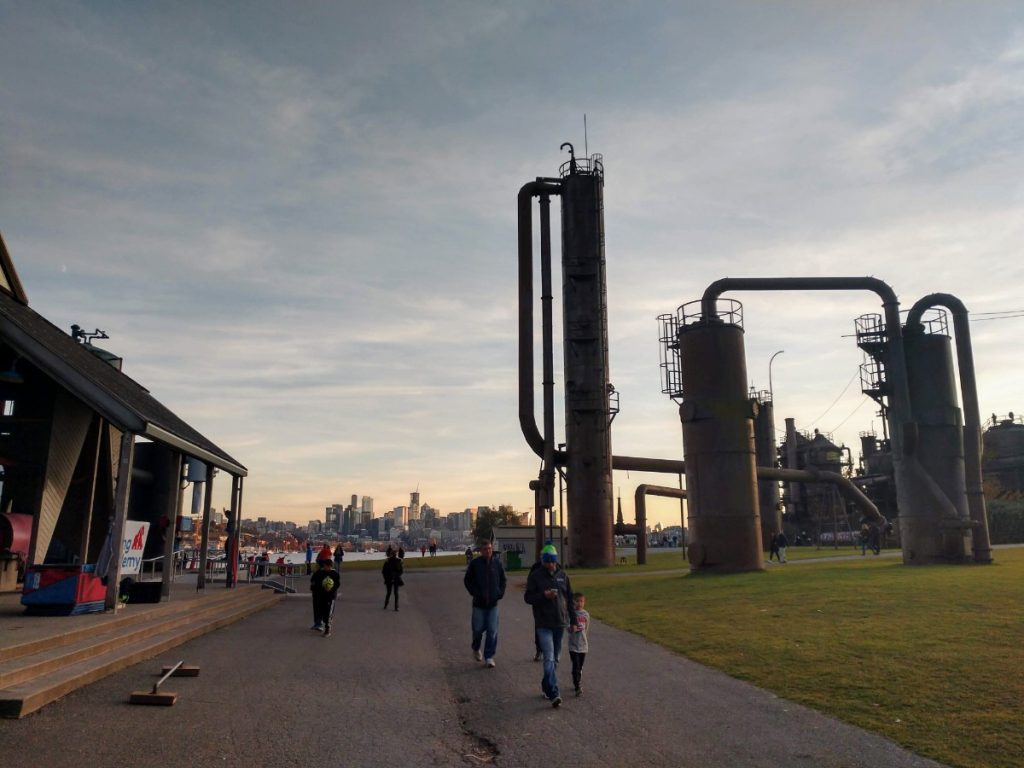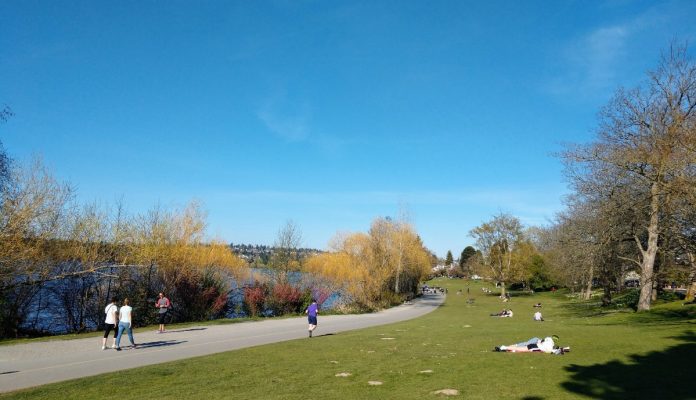In a move to combat coronavirus spread, Mayor Jenny Durkan announced yesterday that 15 of Seattle’s largest or most popular parks would be closed this weekend and urged residents to stay home. The parks–Alki, Arboretum, Cal Anderson, Carkeek, Discovery, Gas Works, Green Lake, Golden Gardens, Kubota Garden, Lincoln, Magnuson, Seward, Volunteer, West Seattle Stadium, Woodland–represent more than 2,500 acres or four square miles–about 5% of the city’s land mass.
The park closure goes into effect at 11pm today (Friday) and ends on 4:30am on Monday April 13th.
“These are the beautiful weather days we crave all winter, but we are living in unprecedented times and the Governor’s order isn’t stay out–it’s stay home,” Mayor Durkan said in a statement. “Seattle’s frontline medical workers, vulnerable residents, and displaced workers need you to stay home. While Seattle is expecting near perfect weather, friends and families should not have family or friend outings, picnics or gatherings in parks. Stay home unless you need to go to an essential job or business. If you need to take a walk in your neighborhood, be smart and don’t help create a crowded place.”
While presented as a needed sacrifice, Mayor Durkan has yet to announce any proactive measures to help people get around the city without a two-ton personal vehicle shielding them. Walking to the grocery store is an essential trip, as is biking to work for some medical and food service workers. Other cities such as Denver, Portland, and Minneapolis have closed some streets to cars in order to help pedestrians and cyclists coexist with proper physical distancing of at least six feet. Seattle has been slow to join the party.
Governor Jay Inslee’s stay-at-home order included an allowance for a daily outdoor exercise such as a walk, bike ride, or jog so help state residents maintain their physical fitness and mental wellbeing. How those walks can safely happen on city sidewalks that often manage just six feet in width is another question which the City has been slow to offer a response. Instead the Mayor’s press release puts the blame on park users and notes the City is not alone in this decision.
“Because of continued gatherings in major parks and crowded public places, the City of Seattle announced today the full closure of major regional parks this weekend where social distancing guidelines have not been followed by patrons,” the release said. “Seattle is joining major cities like Austin and Los Angeles across the country in closing major parks for the weekend.”
The excuse of rampant flouting of the rules offers a bit of explanation why certain parks remain open, some of them bigger or more popular than smaller parks that were closed–like the seven-acre Cal Anderson and Gas Works and Kubota Gardens, which are each 20 acres. Queen Anne’s Kerry Park remains open despite being perhaps Seattle most popular selfie spot, as is the Seattle Center, Genesse Park, and West Seattle’s Schmitz Park. Arguably closing three parks in West Seattle but leaving a few open may exacerbate overcrowding in them.
The Mayor’s fear was that warm weather and the dawning of spring would incite too many Seattleites out of their stuffy homes and into blossoming parks to recreate to the point of overcrowding. “Too many friends, residents and families are continuing to gathering for picnics, BBQs, basketball games, and group walks,” she noted. But closing the parks entirely is a blunt instrument and not the most prudent use of city resources. Mayor Durkan said police would be out to “remind” people to comply with the order.
“The Police Department supports the Mayor’s decision to close the parks, and we will work with the Parks Department to carry out this order,” Seattle Police Chief Carmen Best said in a statement. “However, the Seattle Police Department cannot police us out this pandemic. Please stay at home for the health and safety of your family, friends, and loved ones.”

What if those authorities were helping pedestrians get around safely rather than cordoning off of the most peaceful parts of the city amidst a stressful pandemic? These police officers and park employees could be staffing open streets events rather than barricading 5% of the city.
Seattle Neighborhood Greenways has been pushing the city to declare more “people streets” where car traffic is limited and discouraged in order to promote safe use of the streets for people walking, rolling, and biking. On Wednesday, the group announced some progress as Seattle Parks announced the roads through Volunteer Park and Seward Park would be closed to cars and released its recommended street closures and a survey for more ideas. Unfortunately the next day it was announced those two parks were to be closed to everybody (not just cars) this week negating the immediate benefit.
Several of the roads that Seattle Greenways highlighted were roads accessing the major parks that will be closed. Lake Washington Boulevard, which leads to Seward Park, was a frequently mentioned target for closure since Seattle Parks already has a summer program of weekend closures to promote recreation along the corridor, which was designed by the Olmsted brothers and is technically a linear park.
Similarly Alki Avenue SW runs along Alki Beach, Green Lake Way N runs along Green Lake Park, and E Galer Street and Interlaken Drive E lead to Volunteer Park. Closing these streets would have multiple benefits. First off, making it harder to drive to or through these parks will decrease crowding–and parking lots had already been closed at many of these parks with this goal in mind. Secondly, it makes it easier for the pedestrians and cyclists using these spaces to maintain physical distancing since they’ll be able to use the road space to keep six-feet or more away from others. Thirdly, reducing car traffic makes these spaces more pleasant places to be, which increases the stress reduction and health benefits of using them in the first place.

On one hand, Mayor Durkan’s intent in closing parks is understandable, perhaps even commendable if it does succeed in reducing community virus spread. But, on the other hand, it’s not realistic to close parks every nice weekend that comes along. Many of us will lose our minds this spring and summer if park closures persist, and it will likely be felt more acutely among the many renters not blessed with their own personal quarter acre of green space that many homeowners take for granted.
The better solution is to promote the safe use of our fantastic park system and find ways for people to be outside without putting each other in danger. Closing streets to cars serves this aim by helping pedestrians spread out, both to access parks or to mosey around without every stepping foot in the busiest parts of our parks. That’s why we should declare a people street in every neighborhood in Seattle and limit car traffic on that key active transportation artery. Not having the ability to drive right into the park will spread out crowds and lessen the surges of people that happens in our parks given the lack of alternatives.
Fill out Seattle Greenways’ short survey to suggest additional ideas and street candidates for closure.
When this is all over, we may find that we like some of our streets better as people-first parkways and leave them that way. Our cities don’t have to be as isolating as we have designed them to be. Let’s give people walking, rolling, and biking room to roam.
Doug Trumm is publisher of The Urbanist. An Urbanist writer since 2015, he dreams of pedestrian streets, bus lanes, and a mass-timber building spree to end our housing crisis. He graduated from the Evans School of Public Policy and Governance at the University of Washington in 2019. He lives in Seattle's Fremont neighborhood and loves to explore the city by foot and by bike.


